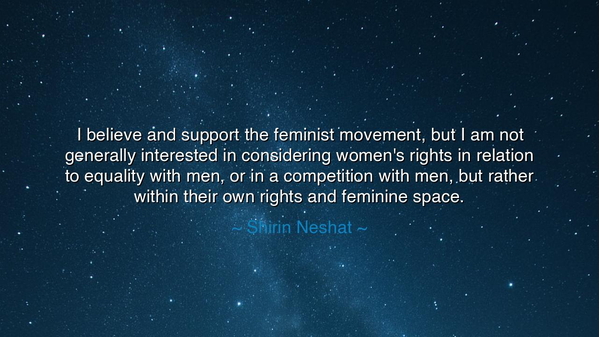
I believe and support the feminist movement, but I am not
I believe and support the feminist movement, but I am not generally interested in considering women's rights in relation to equality with men, or in a competition with men, but rather within their own rights and feminine space.






In the eloquent and contemplative words of Shirin Neshat, the Iranian artist and visionary, there shines a profound truth about identity and liberation: “I believe and support the feminist movement, but I am not generally interested in considering women's rights in relation to equality with men, or in a competition with men, but rather within their own rights and feminine space.” These words emerge not from defiance of feminism’s ideals, but from a deeper yearning to redefine them—to root the concept of freedom not in comparison, but in authenticity. Neshat’s reflection is both gentle and revolutionary, for she speaks of feminine strength not as imitation of masculinity, but as the flowering of a unique, self-contained power that has always existed, even when unseen.
The meaning of this quote lies in its invitation to understand feminism not as rivalry, but as restoration. Too often, societies have measured women’s progress by how closely they mirror men’s accomplishments—how equally they earn, lead, or conquer. Neshat does not dismiss these measures; she honors them. Yet she calls us to something deeper: a feminism of essence, not comparison. She believes that women’s liberation must not erase their difference, but exalt it. Equality, in her vision, is not sameness; it is the recognition that the feminine—its intuition, its empathy, its creativity, its capacity for endurance—is sacred and self-sufficient. Her art and her words remind us that the power of womanhood need not be proven by competing with men, but by fully inhabiting the vast, spiritual landscape of the feminine self.
The origin of this conviction flows from Neshat’s own life, shaped by exile, culture, and resistance. Born in Iran and later living in the West, she carries within her two worlds—one steeped in the beauty and restrictions of Persian tradition, the other in the freedoms and contradictions of modern feminism. Her art, particularly her haunting series Women of Allah, explores this tension: women veiled and unveiled, silent and speaking, captive yet defiant. In these images, the female body becomes both battlefield and sanctuary—a symbol of suffering and transcendence. When Neshat speaks of a “feminine space,” she speaks as one who has seen that the world’s understanding of power is often too narrow, too masculine, too linear. Her work seeks to reclaim a spiritual and emotional strength that belongs to women as their birthright, independent of any man’s reflection.
History offers mirrors to Neshat’s wisdom. Consider the life of Rabia al-Adawiyya, the great Sufi mystic of the 8th century, whose devotion and insight made her one of the most revered figures in Islamic spirituality. She did not seek equality with the male scholars of her time, nor compete for their recognition. Instead, she entered into the sacred realm of divine love, claiming her own spiritual authority through her relationship with the eternal. When asked if she loved God for fear of hell or desire for heaven, she replied, “I love Him for Himself.” In that same spirit, Neshat’s words remind us that women must define themselves for themselves, not in response to the standards or approval of men. True freedom is not found in contest, but in wholeness.
Neshat’s insight also carries a quiet defiance of the Western model of feminism, which often equates empowerment with the adoption of masculine forms of power—career, competition, conquest. Her vision restores balance, reminding us that feminine strength has always thrived in different dimensions: in the power to create life, to nurture community, to endure suffering with grace, to transform pain into art, silence into song. The “feminine space” she speaks of is not confinement—it is creation. It is the inner sanctum where women reclaim their voices, their myths, their divine inheritance. In that sacred space, woman is not an echo of man, but the origin of her own sound.
And yet, her message is not one of separation, but of harmony. For Neshat does not reject equality; she deepens it. She reminds us that men and women are not meant to mirror one another, but to complement one another—like day and night, reason and intuition, structure and spirit. In recognizing the feminine as equal in power but distinct in nature, we restore balance to a world long distorted by one-sided strength. Her words are both a critique and a blessing—a call to remember that liberation without love, progress without identity, is only another form of captivity.
Therefore, O listener, take this lesson as both meditation and mandate: do not measure your worth by another’s shadow. Whether you are woman or man, seek the source of your power within yourself. Honor the feminine in your being—the part that feels, creates, forgives, and nurtures life. In a world obsessed with noise, protect your inner silence; in a culture that glorifies conquest, cultivate compassion. Feminism, as Neshat teaches, is not a war cry—it is a song of remembrance. It is the rediscovery of what was always sacred, hidden beneath the rubble of comparison.
And so, remember the enduring wisdom of Shirin Neshat: that equality does not demand imitation, and that the feminine spirit needs no validation beyond its own truth. Let every woman learn to build her own temple of strength, and every man learn to honor its light. For when the feminine is allowed to rise in her own right—not as rival, but as equal in essence—the world itself will be healed, balanced once more between wisdom and will, between strength and grace.






AAdministratorAdministrator
Welcome, honored guests. Please leave a comment, we will respond soon